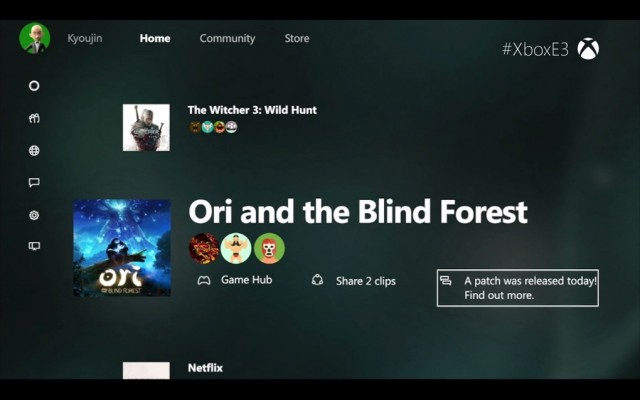While backwards compatibility is certainly the talk of Microsoft’s conference this year, there are a bunch of other platform updates coming to Xbox One that are very much worth noting.
In a closed-door session at Xbox today, we got the pleasure of seeing some of these things in action, and they focus around three major things: a new interface, the aforementioned backward compatibility, and game streaming.
The new interface is the biggest change, and perhaps the most welcome. It does away with most of the tiled interface that was ushered in with Windows 8 and migrates to an interface that is almost more reminiscent of Sony’s XrossMediaBar on the PlayStation 3. (And yes, that’s how Sony spells the word ‘cross.’ The company also doesn’t care much for spaces, it seems.)
Speed is the main focus of this update, and the interface was changed so that players could interact less with a menu screen and more with their games and other content. Rather than a series of tiles on each page, there is a greater emphasis on vertical lists. The left-right menu mechanic is still in place but it is augmented by sub-sections below each main one, presumably making it easier to find the content that is most important.

Game titles are huge and emblazoned across the front of the screen, and contextual actions are available without having to launch into the game. For example, getting into the game hub doesn’t involve loading up the game first. Neither does sharing a screenshot or getting some news from the developer, both of which are visible under the title itself.
The community tab also makes it a lot easier to see what content is being shared by friends and notable players in the Xbox community. Microsoft used the example of players close to reaching the one million Gamerscore mark, but we’d be willing to bet they’ll highlight gamers’ success for all sorts of things.
Backward compatibility also had a few more questions answered in this session. Most notably, it looks like the game itself will indeed live on the hard drive of the Xbox One, but it will still require the disc to play, assuming it wasn’t originally purchased online.
We were told that the Xbox One is actually getting an Xbox 360 software emulator, so however a game would play on the 360 is how it will play on the Xbox One. That goes for the Xbox Guide, too, as it is back, complete with the same graphics you know and love circa, well, 2013. It also means that Xbox One features can be loaded over top of the game, so things like Game DVR and Twitch streaming will just work.
And so will playing online against someone who is using an actual Xbox 360. Pretty sweet stuff.
Digital games from the 360 will automatically be ready for download on the Xbox One if that game is one with backwards compatibility. As of this writing, only about two dozen games are available for play, and only for Xbox Preview Program members.
Finally, game streaming is the last of the big announcements for the Xbox platform itself. With game streaming, if someone kicks you off the couch, you can stream your Xbox One or Xbox 360 title to a Windows 10 PC or laptop and pick up right where you left off. The game is running locally on the Xbox and streaming through to the PC which is essentially just acting as a monitor.
No word yet if you can do this with actual television inputs, nor whether or not the devices need to be on the same network. For example, if I’m on vacation in Europe, can I turn on my Xbox and play some Halo 5: Guardians while it’s sitting at home in Toronto? Could I watch some local Canadian television while I’m on the other side of the Atlantic?
Those questions will likely be answered as users in the Xbox Preview Program are able to test it now, while the rest of the human race waits until this holiday season for the update to officially go live.
It is worth mentioning that Cortana was also announced to be a feature of the new Xbox One experience, but there wasn’t enough time in the session to go hands-on, so we couldn’t test out the feature.


